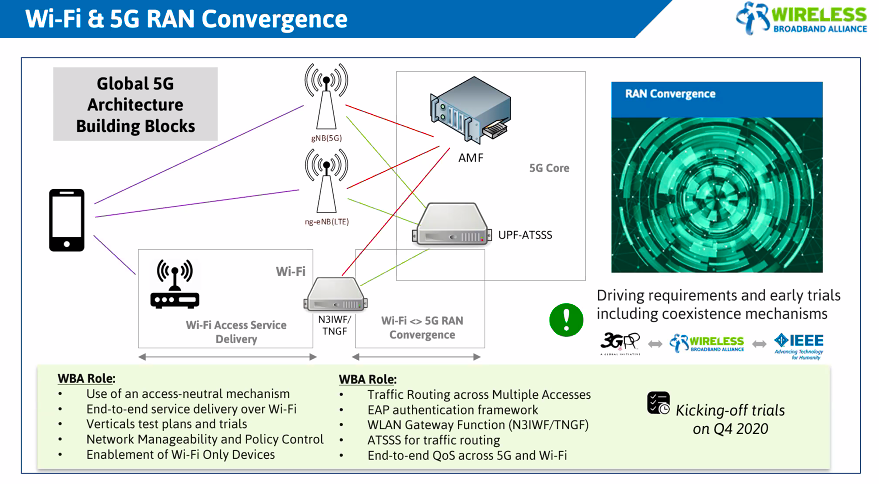With Wi-Fi 6 and 5G convergence, the connectivity experience would be completely seamless
When it comes to how Wi-Fi 6 and 5G will work together in future networks, coexistence is a common diagnosis among those in the industry, and the only Wi-Fi and cellular combo really present today. However, there is also a strong case for Wi-Fi 6 and 5G convergence, which would mean that the two technologies are combined into a single radio network pillar for some larger venues.
“The convergence idea,” Wireless Broadband Alliance’s (WBA) Director Bruno Tomas explained RCR Wireless News, “is that if there is a network that is providing a certain service, from the standpoint of the mobile or cable operator, they integrate Wi-Fi into their core network.”
Currently, when a cellular network is deployed, there are always some centralized pieces of hardware and software that manage the base station. But, with Wi-Fi 6 and 5G convergence, WBA hopes that “finally, there is a new interface that allows the carrier to really say that Wi-Fi is just one more radio in their aggregate strategy.”
“The rules for me to connect to that Wi-Fi are defined by the mobile operator itself and when you attach to those networks, you are using all the services you would use in 5G on the Wi-Fi connection,” Tomas said. “Continuity. It would be completely seamless. The vision is that when I turn my data on, everything is converged, so someone else decides what is best for me, depending on what I pay for my data and on network metrics.”
Some of those technical details of convergence were highlighted in a study published by 3GPP, which examined the feasibility of convergence by looking specifically at LAN support for 5G.21 and how 5G LAN-type services could provide LAN emulation capability that works with both Wi-Fi and mobile wireless networks. This, the study posits, would eliminate the need for a Wi-Fi backbone, and Wi-Fi and mobile devices would connect to a single radio network that is based on 5G technology.
In addition, many in the industry point to the fact that the 3GPP standards have announced the adoption of unlicensed spectrum at 6 GHz, the same spectrum allocated for Wi-Fi 6, as a good indication that convergence will occur because this opens up the opportunity for a distributed antenna system (DAS) to support both licensed and unlicensed spectrum, which would communicate with both Wi-Fi and mobile devices.
For mobile operators, according to The RAN Convergence White Paper developed by WBA and the Next Generation Mobile Networks (NGMN) Alliance, Wi-Fi and 5G convergence offers improved visibility into Wi-Fi networks, allowing them more control over customer experiences and the ability to provide better service. Further, mobile operators are in a better position to provide enterprise Wi-Fi network management solutions to enterprise customers.
 On the Wi-Fi side of things, the paper stated that, as the two technologies converge, Wi-Fi operators will also be able to provide an enhanced user experience through increased visibility and improved transition management as they operate overlapping cellular and Wi-Fi networks. Additionally, enterprise Wi-Fi networks will gain the ability to access operator-provided 5G services.
On the Wi-Fi side of things, the paper stated that, as the two technologies converge, Wi-Fi operators will also be able to provide an enhanced user experience through increased visibility and improved transition management as they operate overlapping cellular and Wi-Fi networks. Additionally, enterprise Wi-Fi networks will gain the ability to access operator-provided 5G services.
Wi-Fi vendors, in particular, have been vocal about the importance of convergence. Last year, for instance, Boingo CTO Derek Peterson stated that the company “strongly believes in convergence,” adding that those in the industry will “need all the technologies.”
Charter Communications and Cisco Systems have also expressed interest in how Wi-Fi 6 and 5G will work alongside each other, with Cisco CEO Chuck Robbins commenting at last year’s Mobile World Congress trade show that “Wi-Fi 6 and 5G are made to work together.”
Convergence for Fixed Wireless Access
LitePoint’s Director of Product Marketing Adam Smith believes that Fixed Wireless Access (FWA) is the “perfect use for the combination of Wi-Fi and 5G,” and is where the two become truly like “peanut butter and jelly,” arguing that, when it comes to FWA, the two technologies are “just perfect” when put together.
FWA is a method of providing wireless connectivity to homes and businesses through radio links between two fixed points without the need for fiber and cables for last mile connectivity. Laying and maintaining fiber can be prohibitively expensive in many circumstances, such as rural and suburban environments, making FWA, which can still deliver ultra-high-speed broadband an attractive option.
5G FWA features New Radio in the millimeter wavelength and employs standardized 3GPP architectures and common mobile components, providing a competitive alternative to fixed-line DSL, Cable and fiber across all markets.
A provider can potentially, according to Smith, use 5G FWA to bring that mmWave signal into a building, where it is then distributed over Wi-Fi.
“Speaking strictly from a use-case point of view, I see FWA as a great example of a convergence of 5G and Wi-Fi,” he said. “In this use-case, 5G is an ideal solution to bring a ‘fat data pipe’ wide-area connection to an office, residence or venue, which solves the fiber challenge of digging up streets. Once the building is connected, Wi-Fi is an ideal technology to translate that carrier-specific wide-area connection to a local area connection over the unlicensed spectrum.”
He called the challenge of getting high frequency signals into building “a fundamental physics problem,” adding, that when it comes to sub 6 GHz 5G (FR1), massive MIMO and beamforming can be used on the base station side to get the signal strong enough to get into a building, but that in the case of mmWave (FR2), doing so “very problematic.”
Smith went on to explain that a FWA for a mmWave network, an external “outdoor unit” (ODU) can be wired to an indoor unit (IDU), adding that it might be more common, particularly for enterprise and venue scenarios, to see the ODU placed in a convenient line-of-sight spot to the carrier’s mmWave base station, and then umbilical to the IDU.

